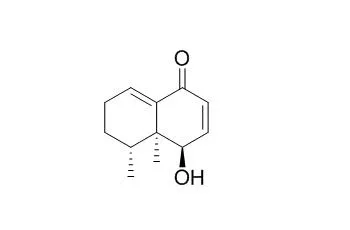| Description: |
Desoxo-narchinol A exhibits protective effects against LPS-induced endotoxin shock and inflammation through p38 deactivation, it shows inhibitory activity against LPS-induced NO production.
Desoxo-narchinol A shows cytotoxic activity against P-388 cells. |
| Targets: |
IL Receptor | TNF-α | NF-kB | p38MAPK | NOS | COX | NO | JNK | ERK | PGE |
| In vitro: |
| Bioorg Med Chem Lett. 2012 Jan 1;22(1):706-8. | | Inhibitory constituents of Nardostachys chinensis on nitric oxide production in RAW 264.7 macrophages.[Pubmed: 22079762 ] |
METHODS AND RESULTS:
The activity-guided fractionation of the MeOH extract of the rhizomes and roots of Nardostachys chinensis led to the isolation of two new sesquiterpenoids, narchinol B (8) and narchinol C (9), along with 10 known compounds, ursolic acid (1), nardosinone (2), pinoresinol (3), Desoxo-narchinol A (4), kanshone B (5), epoxyconiferyl alcohol (6), debilon (7), 4α,5-dimethyl-1,3-dioxo-1,2,3,4,4α,5,6,7-octahydronaphthalene (10), p-coumaric acid (11), and isoferulic acid (12). Their structures were determined using spectroscopic techniques, which included 1D- and 2D-NMR.
CONCLUSIONS:
Among the isolates, compounds 2, 4, 5, 8 and 9 showed inhibitory activity against LPS-induced NO production with IC(50) values of 4.6-21.6 μM. |
|
| In vivo: |
| Int Immunopharmacol. 2015 Dec;29(2):730-738. | | Anti-inflammatory effect of desoxo-narchinol-A isolated from Nardostachys jatamansi against lipopolysaccharide.[Pubmed: 26371857] |
We previously reported that Nardostachys jatamansi (NJ) exhibits anti-inflammatory activity against lipopolysaccharide (LPS). However, the active compound in NJ is unknown.
METHODS AND RESULTS:
Therefore, here, we examined the effects of Desoxo-narchinol A (DN) isolated from NJ against LPS-induced inflammation. To demonstrate the anti-inflammatory effect of DN against LPS, we used two models; murine endotoxin shock model for in vivo model, and peritoneal macrophage responses for in vitro. In endotoxin shock model, DN was administrated intraperitoneally 1h before LPS challenge, then we evaluated mice survival rates and organ damages. Pretreatment with DN (0.05mg/kg, 0.1mg/kg, or 0.5mg/kg) dramatically reduced mortality in a murine LPS-induced endotoxin shock model. Furthermore, DN inhibited tissue injury and production of pro-inflammatory cytokines, such as interleukin (IL)-1β, IL-6, and tumor necrosis factor alpha (TNF-α), in the liver and lung. In in vitro macrophage model, we examined the inflammatory mediators and regulatory mechanisms such as mitogen-activated protein kinases (MAPKs) and nuclear factor kappa B (NF-κB). DN inhibited the production of inflammatory mediators, such as inducible nitric oxide synthase (iNOS) and its derivative nitric oxide (NO), cyclooxygenase-2 (COX-2), prostaglandin E2 (PGE2), IL-1β, IL-6 and TNF-α and H3 protein acetylation in murine peritoneal macrophages. DN also inhibited p38 activation, but not extracellular signal-regulated kinase (ERK), c-jun NH2-terminal kinase (JNK), and NF-κB.
CONCLUSIONS:
These results suggest that DN from NJ exhibits protective effects against LPS-induced endotoxin shock and inflammation through p38 deactivation. |
|






 Cell. 2018 Jan 11;172(1-2):249-261.e12. doi: 10.1016/j.cell.2017.12.019.IF=36.216(2019)
Cell. 2018 Jan 11;172(1-2):249-261.e12. doi: 10.1016/j.cell.2017.12.019.IF=36.216(2019) Cell Metab. 2020 Mar 3;31(3):534-548.e5. doi: 10.1016/j.cmet.2020.01.002.IF=22.415(2019)
Cell Metab. 2020 Mar 3;31(3):534-548.e5. doi: 10.1016/j.cmet.2020.01.002.IF=22.415(2019) Mol Cell. 2017 Nov 16;68(4):673-685.e6. doi: 10.1016/j.molcel.2017.10.022.IF=14.548(2019)
Mol Cell. 2017 Nov 16;68(4):673-685.e6. doi: 10.1016/j.molcel.2017.10.022.IF=14.548(2019)